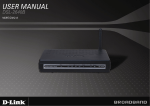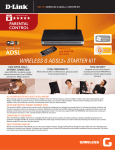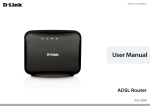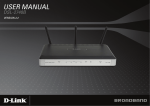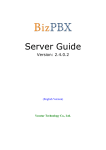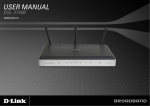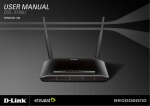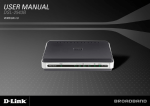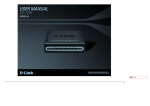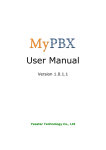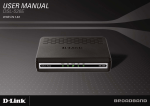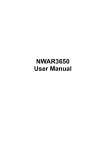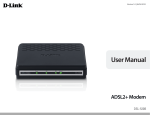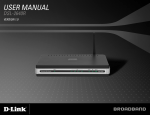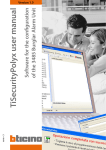Download User Manual Eng. - Advance Bell Company Limited (@Bell)
Transcript
Federal Communication Commission Interference Statement This equipment has been tested and found to comply with the limits for a Class B digital device, pursuant to Part 15 of the FCC Rules. These limits are designed to provide reasonable protection against harmful interference in a residential installation. This equipment generates, uses and can radiate radio frequency energy and, if not installed and used in accordance with the instructions, may cause harmful interference to radio communications. However, there is no guarantee that interference will not occur in a particular installation. If this equipment does cause harmful interference to radio or television reception, which can be determined by turning the equipment off and on, the user is encouraged to try to correct the interference by one of the following measures: - Reorient or relocate the receiving antenna. Increase the separation between the equipment and receiver. Connect the equipment into an outlet on a circuit different from that to which the receiver is connected. Consult the dealer or an experienced radio/TV technician for help. This device complies with Part 15 of the FCC Rules. Operation is subject to the following two conditions: (1) This device may not cause harmful interference, and (2) this device must accept any interference received, including interference that may cause undesired operation. FCC Caution: Any changes or modifications not expressly approved by the party responsible for compliance could void the user's authority to operate this equipment. IMPORTANT NOTE: FCC Radiation Exposure Statement: This equipment complies with FCC radiation exposure limits set forth for an uncontrolled environment. This equipment should be installed and operated with minimum distance 20cm between the radiator & your body. This transmitter must not be co-located or operating in conjunction with any other antenna or transmitter. IEEE 802.11b or 802.11g operation of this product in the U.S.A. is firmware-limited to channels 1 through 11. Table of Contents Before You Begin ...............................................................................................1 Package Contents ......................................................................................................1 System Requirements ................................................................................................1 Features .....................................................................................................................2 HARDWARE OVERVIEW ..................................................................................................3 Connections.......................................................................................................3 LED Indicators ...................................................................................................4 INSTALLATION..................................................................................................................5 Mounting the Device on the Wall................................................................................5 Installation Notes........................................................................................................6 Information you will need from your ADSL service provider...............................8 Information you will need about DSL-2640B......................................................9 Information you will need about your LAN or computer: ....................................9 Device Installation .................................................................................................... 10 Power on Router .............................................................................................. 10 Factory Reset Button ....................................................................................... 10 Network Connections....................................................................................... 11 INTRODUCTION TO WEB CONFIGURATION................................................................ 12 Preparation Before Login ......................................................................................... 12 Logging In to the Modem ......................................................................................... 13 First-Time Login ............................................................................................... 13 Home Configuration ................................................................................................. 15 Wizard.............................................................................................................. 15 Basic Wireless Configuration ........................................................................... 24 WAN Configuration .......................................................................................... 27 LAN Configuration ........................................................................................... 53 IPv6 LAN Configuration ................................................................................... 54 DNS Configuration ........................................................................................... 55 Dynamic DNS .................................................................................................. 56 Logout.............................................................................................................. 58 Advanced Configuration ........................................................................................... 59 ADSL Configuration ......................................................................................... 59 NAT-Virtual Server Configuration ..................................................................... 62 DMZ Host......................................................................................................... 64 SNMP Configuration ........................................................................................ 65 IP Filter Configuration ...................................................................................... 66 Parental Control ............................................................................................... 73 Routing Configuration ...................................................................................... 74 QoS.................................................................................................................. 78 UPNP Configuration......................................................................................... 84 Port Mapping ................................................................................................... 85 LAN Ports ........................................................................................................ 88 Certificate......................................................................................................... 89 Wireless Configuration..................................................................................... 93 Tools Configuration .................................................................................................. 97 Access Control................................................................................................. 97 Internet Time.................................................................................................. 101 System Log.................................................................................................... 102 TR-069 Client................................................................................................. 105 System Settings............................................................................................. 106 Update Firmware ........................................................................................... 107 Test ................................................................................................................ 108 Status ..................................................................................................................... 109 Summary Information of the Router............................................................... 109 DHCP Client .................................................................................................. 109 WAN Interface Information............................................................................. 110 Route Table Information................................................................................. 110 System Log.....................................................................................................111 Statistics of LAN..............................................................................................111 Statistics of WAN ........................................................................................... 112 Statistics of ATM ............................................................................................ 113 Statistics of ADSL .......................................................................................... 114 Wireless Station Information .......................................................................... 115 TROUBLESHOOTING ................................................................................................... 116 NETWORKING BASICS ................................................................................................ 117 Check Your IP Address.......................................................................................... 117 Statically Assign An IP Address ............................................................................. 118 TECHNICAL SPECIFICATIONS .................................................................................... 119 Product Overview Before You Begin Please read and make sure you understand all the prerequisites for proper installation of your new Router. Have all the necessary information and equipment on hand before beginning the installation. Package Contents DSL-2640B ADSL Router Power Adapter CD-ROM with User Manual One twisted-pair telephone cable used for ADSL connection One straight-through Ethernet cable One Quick Installation Guide Warning: The Router must be used with the power adapter included with the device. System Requirements • ADSL Internet service • Computer with: • 200 MHz Processor • 64MB Memory • CD-ROM Drive • Ethernet Adapter with TCP/IP Protocol Installed • Internet Explorer v6 or later, FireFox v1.5 • Computer with Windows 2000, Windows XP, or Windows Vista D-Link DSL-2640B User Manual 1 Product Overview 1 Features • • • • • • • • • • PPP (Point-to-Point Protocol) Security – The DSL-2640B ADSL Router supports PAP (Password Authentication Protocol) and CHAP (Challenge Handshake Authentication Protocol) for PPP connections. The Router also supports MSCHAP. DHCP Support – Dynamic Host Configuration Protocol automatically and dynamically assigns all LAN IP settings to each host on your network. This eliminates the need to reconfigure every host whenever changes in network topology occur. Network Address Translation (NAT) – For small office environments, the DSL-2640B allows multiple users on the LAN to access the Internet concurrently through a single Internet account. This provides Internet access to everyone in the office for the price of a single user. NAT improves network security in effect by hiding the private network behind one global and visible IP address. NAT address mapping can also be used to link two IP domains via a LAN-to-LAN connection. TCP/IP (Transfer Control Protocol/Internet Protocol) – The DSL-2640B supports TCP/IP protocol, the language used for the Internet. It is compatible with access servers manufactured by major vendors. RIP-1/RIP-2 – The DSL-2640B supports both RIP-1 and RIP-2 exchanges with other routers. Using both versions lets the Router to communicate with all RIP enabled devices. Static Routing – This allows you to select a data path to a particular network destination that will remain in the routing table and never “age out”. If you wish to define a specific route that will always be used for data traffic from your LAN to a specific destination within your LAN (for example to another router or a server) or outside your network (to an ISP defined default gateway for instance). Default Routing – This allows you to choose a default path for incoming data packets for which the destination address is unknown. This is particularly useful when/if the Router functions as the sole connection to the Internet. Precise ATM Traffic Shaping – Traffic shaping is a method of controlling the flow rate of ATM data cells. This function helps to establish the Quality of Service for ATM data transfer. Full Network Management – The DSL-2640B incorporates SNMP (Simple Network Management Protocol) support for web-based management and text-based network management. Easy Installation – The DSL-2640B uses a web-based graphical user interface program for convenient management access and easy set up. Any common web browser software can be used to manage the Router. D-Link DSL-2640B User Manual 2 Product Overview Hardware Overview Connections D-Link DSL-2640B User Manual 3 Product Overview LED Indicators Front Panel Side Panel LED Power Color Green Red LAN 1/2/3/4 Green WLAN Green DSL Green Internet Green Red WPS (on the side panel) Blue D-Link DSL-2640B User Manual Status Off On On Off Blink On Off Blink On Off Blink On Off Blink On On Off Blink On Description Power not supplied. Power supplied. Not bootable or device is malfunction. No LAN link. Data is being transmitted through the LAN interface. LAN link is established and active. WLAN is disabled. WLAN traffic is flowing. WLAN link is established. DSL line is disconnected. DSL line is training. DSL line is connected. The device is under the Bridge mode, DSL connection is not present, or the power is off. DSL traffic is flowing. IP is connected. The device is attempted to become IP connected, but failed. Device is ready for new WPS to setup. WPS is successfully triggered Connection is successfully established between the router and the client, the LED would remain in solid light for 5s. 4 Installation Installation This section will walk you through the installation process. Placement of the Wireless ADSL Router is very important. Do not place the Router in an enclosed area such as a closet, cabinet, or in the attic or garage. Place the Wireless ADSL Router in a location where it can be easily connected to Ethernet devices, the telephone line as well as to a power source. Mounting the Device on the Wall Step 1 Step 2 Step 3 There are two slots on the device bank. Install two screws on the wall according to the positions of the slots. Keep the two screws at the same horizontal level. Gently fasten the two slots with the screws. Slowly take your hands off the device. Ensure that the device is properly mounted on the wall with the support of the screws. See the following figure: D-Link DSL-2640B User Manual 5 Installation Installation Notes In order to establish a connection to the Internet it will be necessary to provide information to the Router that will be stored in its memory. For some users, only their account information (Username and Password) is required. For others, various parameters that control and define the Internet connection will be required. You can print out the two pages below and use the tables to list this information. This way you have a hard copy of all the information needed to setup the Router. If it is necessary to reconfigure the device, all the necessary information can be easily accessed. Be sure to keep this information safe and private. Low Pass Filters Since ADSL and telephone services share the same copper wiring to carry their respective signals, a filtering mechanism may be necessary to avoid mutual interference. A low pass filter device can be installed for each telephone that shares the line with the ADSL line. These filters are easy to install passive devices that connect to the ADSL device and/or telephone using standard telephone cable. Ask your service provider for more information about the use of low pass filters with your installation. Operating Systems The DSL-2640B uses an HTML-based web interface for setup and management. The web configuration manager may be accessed using any operating system capable of running web browser software, including Windows 98 SE, Windows ME, Windows 2000, Windows XP, and Windows Vista. Web Browser Any common web browser can be used to configure the Router using the web configuration management software. The program is designed to work best with more recently released browsers such as Opera, Microsoft Internet Explorer® version 6.0, Netscape Navigator® version 6.2.3, or later versions. The web browser must have JavaScript enabled. JavaScript is enabled by default on many browsers. Make sure JavaScript has not been disabled by other software (such as virus protection or web user security packages) that may be running on your computer. Ethernet Port (NIC Adapter) Any computer that uses the Router must be able to connect to it through the Ethernet port on the Router. This connection is an Ethernet connection and therefore requires that your computer be equipped with an Ethernet port as well. Most notebook computers are now sold with an Ethernet port already installed. Likewise, most fully assembled desktop computers come with an Ethernet NIC adapter as standard equipment. If your computer does not have an Ethernet port, you must install an Ethernet NIC adapter before you can use the Router. If you must install an adapter, follow the installation instructions that come with the Ethernet NIC adapter. Additional Software It may be necessary to install software on your computer that enables the computer to access the Internet. Additional software must be installed if you are using the device as a simple bridge. For a bridged connection, the information needed to make and maintain the Internet connection is stored on another computer or gateway device, not in the Router itself. If your ADSL service is delivered through a PPPoE or PPPoA connection, the information needed to establish and maintain the Internet connection can be stored in the Router. In this case, it is not necessary to install software on your computer. It may however be necessary to change some settings in the device, including account information used to identify and verify the connection. All connections to the Internet require a unique global IP address. For bridged connections, the global IP settings must reside in a TCP/IP enabled device on the LAN D-Link DSL-2640B User Manual 6 Installation side of the bridge, such as a PC, a server, a gateway device such as a router or similar firewall hardware. The IP address can be assigned in a number of ways. Your network service provider will give you instructions about any additional connection software or NIC configuration that may be required. Wireless LAN Computers using the Wireless network can access the Internet or use the embedded 802.1g wireless access point. Wireless workstations must have an 802.1g or 802.1b wireless network card installed to use the Wireless ADSL Router. In addition the workstations must be configured to operate on the same channel and SSID as the Wireless ADSL Router. If wireless security is used, the wireless workstations must be properly configured for the security settings used. D-Link DSL-2640B User Manual 7 Installation Information you will need from your ADSL service provider Username This is the Username used to log on to your ADSL service provider’s network. Your ADSL service provider uses this to identify your account. Password This is the Password used, in conjunction with the Username above, to log on to your ADSL service provider’s network. This is used to verify the identity of your account. WAN Setting / Connection Type These settings describe the method your ADSL service provider uses to transport data between the Internet and your computer. Most users will use the default settings. You may need to specify one of the following WAN Setting and Connection Type configurations (Connection Type settings listed in parenthesis): • PPPoE/PPPoA (PPPoE LLC, PPPoE VC-Mux, PPPoA LLC or PPPoA VC-Mux) • Dynamic IP Address (1483 Bridged IP LLC, 1483 Bridged IP VC-Mux) • Static IP Address (1483 Bridged IP LLC, 1483 Bridged IP VC-Mux, 1483 Routed IP LLC (IPoA) or 1483 Routed IP VC-Mux) • Bridge Mode (1483 Bridged IP LLC or 1483 Bridged IP VC Mux) Modulation Type ADSL uses various standardized modulation techniques to transmit data over the allotted signal frequencies. Some users may need to change the type of modulation used for their service. The default DSL modulation (Auto Synch-Up) used for the Router automatically detects all types of ADSL, ADSL2, and ADSL2+ modulation. Security Protocol This is the method your ADSL service provider will use to verify your Username and Password when you log on to their network. Your Router supports the PAP and CHAP protocols. VPI Most users will not be required to change this setting. The Virtual Path Identifier (VPI) is used in conjunction with the Virtual Channel Identifier (VCI) to identify the data path between your ADSL service provider’s network and your computer. If you are setting up the Router for multiple virtual connections, you will need to configure the VPI and VCI as instructed by your ADSL service provider for the additional connections. This setting can be changed in the WAN Settings window of the web management interface. VCI Most users will not be required to change this setting. The Virtual Channel Identifier (VCI) used in conjunction with the VPI to identify the data path between your ADSL service provider’s network and your computer. If you are setting up the Router for multiple virtual connections, you will need to configure the VPI and VCI as instructed by your ADSL service provider for the additional connections. This setting can be changed in the WAN Settings window of the web management interface. D-Link DSL-2640B User Manual 8 Installation Information you will need about DSL-2640B Username This is the Username needed to access the Router’s management interface. When you attempt to connect to the device through a web browser you will be prompted to enter this Username. The default Username for the Router is “admin.” The user cannot change this. Password This is the Password you will be prompted to enter when you access the Router’s management interface. The default Password is “tot.” The user may change this. LAN IP addresses for the DSL-2640B This is the IP address you will enter into the Address field of your web browser to access the Router’s configuration graphical user interface (GUI) using a web browser. The default IP address is 192.168.1.1. This may be changed to suit any IP address scheme the user desires. This address will be the base IP address used for DHCP service on the LAN when DHCP is enabled. LAN Subnet Mask for the DSL-2640B This is the subnet mask used by the DSL-2640B, and will be used throughout your LAN. The default subnet mask is 255.255.255.0. This can be changed later. Information you will need about your LAN or computer: Ethernet NIC If your computer has an Ethernet NIC, you can connect the DSL-2640B to this Ethernet port using an Ethernet cable. You can also use the Ethernet ports on the DSL-2640B to connect to other computer or Ethernet devices. DHCP Client status Your DSL-2640B ADSL Router is configured, by default, to be a DHCP server. This means that it can assign an IP address, subnet mask, and a default gateway address to computers on your LAN. The default range of IP addresses the DSL-2640B will assign are from 192.168.1.2 to 192.168.1.254. Your computer (or computers) needs to be configured to obtain an IP address automatically (that is, they need to be configured as DHCP clients.) It is recommended that you collect and record this information here, or in some other secure place, in case you have to re-configure your ADSL connection in the future. Once you have the above information, you are ready to setup and configure your DSL-2640B ADSL Router. D-Link DSL-2640B User Manual 9 Installation Device Installation The Wireless ADSL Router maintains three separate interfaces, an ADSL, an Ethernet, and a Wireless LAN interface. Place the Wireless ADSL Router in a location where it can be easily connected to Ethernet devices, the telephone line as well as to a power source. The Router can be placed on a shelf or desktop, ideally you should be able to see the LED indicators on the front if you need to view them for troubleshooting. Power on Router The Router must be used with the power adapter included with the device. 1. Connect the power adapter to the Power Input (12V DC, 1A) on the back panel of the Wireless ADSL Router and plug the other end of the power adapter to a wall outlet or power strip. 2. Push the Power Button to turn the power on. 3. The Power LED on the front panel will shine bright green to indicate the device is powered on. 4. If the Ethernet port is connected to a working device, check the LAN LED indicator to make sure the connection is valid. The Wireless ADSL Router will attempt to establish the ADSL connection, if the ADSL line is connected and the Wireless ADSL Router is properly configured the ADSL LED will light up after several seconds. If this is the first time installing the device, some settings may need to be changed before the Wireless ADSL Router can establish a connection. Factory Reset Button The Router may be reset to the original factory default settings by using a ballpoint or paperclip to gently push down the reset button in the following sequence: 1. With the router powered on (check the Power LED to make sure it lights steady green), press and hold down the reset button using a paper clip or similar object for about 6 to 8 seconds. 2. The router will restart. Watch the Power LED to verify that it is restarting. 3. When it is powered on again it is ready to be configured. The whole process takes about 30 seconds. 4. The device settings will be restored to the factory default IP address 192.168.1.1 and the subnet mask is 255.255.255.0, the default management Username is “admin” and the default Password is “tot.” Note: A factory reset will erase the current configuration settings and reset them to the default settings. After it has restarted, log in to the router’s web-based management interface and use the Setup Wizard to configure the basic settings. D-Link DSL-2640B User Manual 10 Installation Network Connections Connect ADSL Line Use the ADSL cable included with the Router to connect it to a telephone wall socket or receptacle. Plug one end of the cable into the ADSL port (RJ-11 receptacle) on the rear panel of the Router and insert the other end into the RJ-11 wall socket. If you are using a low pass filter device, follow the instructions included with the device or given to you by your service provider. The ADSL connection represents the WAN interface, the connection to the Internet. It is the physical link to the service provider’s network backbone and ultimately to the Internet. Connect Router to Ethernet The Router may be connected to a single computer or Ethernet device through the 10/100BASE-TX Ethernet port on the rear panel. Any connection to an Ethernet concentrating device such as a switch or hub must operate at a speed of 10/100 Mbps only. When connecting the Router to any Ethernet device that is capable of operating at speeds higher than 10Mbps, be sure that the device has auto-negotiation (NWay) enabled for the connecting port. Use standard twisted-pair cable with RJ-45 connectors. The RJ-45 port on the Router is a crossed port (MDI-X). Follow standard Ethernet guidelines when deciding what type of cable to use to make this connection. When connecting the Router directly to a PC or server use a normal straight-through cable. You should use a crossed cable when connecting the Router to a normal (MDI-X) port on a switch or hub. Use a normal straight-through cable when connecting it to an uplink (MDI-II) port on a hub or switch. The rules governing Ethernet cable lengths apply to the LAN to Router connection. Be sure that the cable connecting the LAN to the Router does not exceed 100 meters. Hub or Switch to Router Connection Connect the Router to an uplink port (MDI-II) on an Ethernet hub or switch with a straight-through cable. If you wish to reserve the uplink port on the switch or hub for another device, connect to any on the other MDI-X ports (1x, 2x, etc.) with a crossed cable. Computer to Router Connection You can connect the Router directly to a 10/100BASE-TX Ethernet adapter card (NIC) installed on a PC using the Ethernet cable provided. Wireless Connection to Router The Router’s embedded 802.11g wireless access point should be configured to suit the local wireless network. All 802.11g or 802.11b devices that associate with the Router’s wireless access point must have the same SSID and channel. If wireless security is used, the wireless clients must be configured with the correct security information to use the Router. More information on configuring the wireless settings is found later in this manual. D-Link DSL-2640B User Manual 11 Web Configuration Introduction to Web Configuration The first time you setup the Router. It is recommended that you configure the WAN connection using a single computer, to ensure that both the computer and the Router are not connected to the LAN. Once the WAN connection operates properly, you may continue to make changes to Router configuration, including IP settings and DHCP setup. This chapter is concerned with using your computer to configure the WAN connection. The following chapter describes the various menus used to configure and monitor the Router, including how to change IP settings and DHCP server setup. Preparation Before Login Before accessing the Modem, ensure the communication between PC and Modem is normal. Check the communication as follows. Configure the IP address of the PC as 192.168.1.X (2~254), net mask as 255.255.255.0, gateway address as 192.168.1.1 (for customized version, configure them according to the actual version). Enter arp -a in the DOS window to check whether the PC can read the MAC address of the Modem. Ping the management IP address (192.168.1.1 by default) of the Modem. If the PC can read the MAC address of the Modem and can ping through the management IP address of the Modem, that means the communication of the PC and the Modem is normal. Note: When you manage the Modem through Web, you must keep the Modem power on. Otherwise, the Modem may be damaged. D-Link DSL-2640B User Manual 12 Web Configuration Logging In to the Modem The following description is a detail “How-To” user guide and is prepared for first time users. First-Time Login When you log in to the DSL Router for the first time, the login wizard appears. Step 1 Open a Web browser on your computer. Step 2 Enter http://192.168.1.1 (DSL router default IP address) in the address bar. The login page appears. Step 3 Enter a user name and the password. The default username and password are admin and tot. You need not enter the username and password again if you select the option Remember my password. It is recommended to change these default values after logging in to the DSL router for the first time. Step 4 Click OK to log in or click Cancel to exit the login page. After logging in to the DSL router as a super user, you can query, configure, and modify all configurations, and diagnose the system. You need to reboot the DSL router to enable your modification or configuration effective in some cases, for example, after you modify the PVC configuration. Some modification, such as adding a static route, takes effect at once, and does not require modem reboot. D-Link DSL-2640B User Manual 13 Web Configuration After login into the Router, the page shown in the figure appears. In this page, please type “PPP Username” and “PPP Password” provided by your ISP for PPPoE connection. Click “Save/Reboot” to take the settings into effect. Click “Cancel” to cancel the configuration. Note: If you have not configure the PPP connection, the system will remind you. D-Link DSL-2640B User Manual 14 Web Configuration Click “Advance Setup” to login into the home page. In the left pane, click “Quick Setup” to return to the above page. Home Configuration Wizard This chapter is concerned with using your computer to configure the WAN connection of IP v4. D-Link DSL-2640B User Manual 15 Web Configuration Choose Home > Wizard, the right page appears. D-Link DSL-2640B User Manual 16 Web Configuration Click Next, the right page appears. In this page, there are two users of user and admin, you can select from the drop-down list. Then you can change the user name and password. Note: If you change the user name and password successfully, you need to relogin. The user name or password can only be less than 16 characters. To ignore the step, click Skip. After proper configuration, the right page appears. In this page, you can set the Internet time. To ignore the step, click Skip. D-Link DSL-2640B User Manual 17 Web Configuration After proper configuration, the right page appears. In this page, you can set the WAN service. You can select the protocol from the drop-down list: If you select the Bridge, the page is as the right page. Enter the VPI and VCI, then select the connection mode. z VPI: The virtual path between two points in an ATM network, ranging from 0 to 255. z VCI: The virtual channel between two points in an ATM network, ranging from 32 to 65535 (1 to 31 are reserved for known protocols) z Connection mode: You can choose LLC and VC-Mux. D-Link DSL-2640B User Manual 18 Web Configuration If you select PPPoE or PPPoA as the protocol, the right page appears. Your ISP should provide you with the following information: z PPP Username z PPP Password If you select Dynamic IP as the protocol, the right page appears. D-Link DSL-2640B User Manual 19 Web Configuration If you select Static IP or IPoA as the protocol, the right page appears. Your ISP should provide you with the following information: z WAN IP Address z SubnetMask z Default gateway z Primary DNS server z Secondary DNS server D-Link DSL-2640B User Manual 20 Web Configuration After the WAN service configuration, click Next and the right page appears. In this page, the wireless is enabled by default. You can set the SSID, WPA Pre-Shared Key, and WPA update session Key interval. You can select the Network authentication from the drop-down list. You can select the WPA Encryption from the drop-down list. To ignore the step, click Skip. D-Link DSL-2640B User Manual 21 Web Configuration After the proper wireless settings, the quick setup wizard is finished and the right page appears. Check weather the settings match the settings provided by your ISP. Then it turns to the quick setup page. The quick setup interface is available for the current PVC. Click Save/Reboot to take the settings into effect. Click Cancel to cancel the configuration. Click Advance Setup to continue other settings. Note: If you have not configure the PPP connection, the system will remind you. D-Link DSL-2640B User Manual 22 Web Configuration Click Save/Reboot, the rebooting page appears. D-Link DSL-2640B User Manual 23 Web Configuration Basic Wireless Configuration This page allows you to configure basic features of the wireless LAN interface. You can enable or disable the wireless LAN interface, hide the network from active scans, set the wireless network name (also known as SSID) and restrict the channel set based on country requirements. Following is a description of the different options: Enable Wireless: If you want to make wireless be available, you have to check this box first. Hide Access Point: Check this box if you want to hide any access point for your router, so a station cannot obtain the SSID through passive scanning. Clients Isolation: When many clients connect to the same access point, they can access each other. If you want to disable the access between clients which connect the same access point, you can check this box. Disable WMM Advertise: WMM is short for wi-fi multimedia, which can provide high-performance multimedia voice and video data transfers. SSID: The SSID (Service Set Identification) is the unique name shared among all devices in a wireless network. The SSID must be identical for all devices in the wireless network. Country: The channel will adjust according to nations to adapt to each nation's frequency provision. Max Clients: Specifies maximum wireless client stations to be enble to link with AP. Once the clients exceed the max vlaue, all other clients are refused. The value of maximum clients is 16. Wireless - Guest/Virtual Access Points: If you want to make Guest/Virtual network function be available, you have to check those boxes in the table below. In the current software version, three virtual access points can be configured. Click Apply to save the basic wireless options and make the modification effect. D-Link DSL-2640B User Manual 24 Web Configuration Click Security and the right page appears. This page allows you can configure security features of the wireless LAN interface. You can set the network authentication method, selecting data encryption, specify whether a network key is required to authenticate to this wireless network and specify the encryption strength. WSC Setup: Wi-Fi Simple Config (WSC) is a new method for setting up residential Wi-Fi (802.11) networks with equal emphasis on security and ease-of-use. This device is equipped with 802.1X and WPA/WPA2, the latest security standard. It also supports the legacy security standard, that is, WEP. By default, wireless security is disabled and authentication is open. Before enabling the security, consider your network size, complexity, and existing authentication infrastructure and then determine which solution applies to it. Select SSID: Select the wireless LAN of SSID to configure security features. Network Authentication: Select the authentication mode for the selected wireless LAN of SSID to be open. WEP Encryption: Disable WEP Encryption. D-Link DSL-2640B User Manual 25 Web Configuration Enable WSC: If enable Manual Setup AP, you can not enable WSC. Set WSC AP Mode: If selected Unconfigured, you need to add Client (This feature is available only when WPA-PSK, WPA2 PSK or OPEN mode is configured.), and setup AP (Configure all security settings with an external registar). Device PIN: Device Pin is generated by AP. WSC Add External Registrar: If set WSC AP Mode to Configured, this part will show, and you can add external registrar. Manual Setup AP This device is equipped with 802.1X and WPA/WPA2 (Wi-Fi Protected Access), the latest security standard. It also supports the legacy security standard, WEP (Wired Equivalent Privacy). If you select the “Shared” as the Network Authentication, you can select 64-bit or 128-bit as the Encryption Strength. 64-bit WEP: Enter 5 ASCII characters or 10 hexadecimal digits for 64-bit encryption keys. You can set 4 types of the WEP key. 128-bit WEP: Enter 13 ASCII characters or 26 hexadecimal digits for 128-bit encryption keys. You can set 4 types of the WEP key. The authentication modes are as follows: 802.1X, WPA, WPA-PSK,WPA2, WPA2 –PSK, Mixed WPA2/WPA, Mixed WPA2/WPA –PSK. After proper configuration, click Apply to save the wireless security options and make the modification effect. D-Link DSL-2640B User Manual 26 Web Configuration WAN Configuration Click WAN and the right page appears, so you can modify and configure the WAN interface. Click Add or Remove to configure WAN interface. D-Link DSL-2640B User Manual 27 Web Configuration Internet Connection Type - PPP over Ethernet (PPPoE) Click Add to add the WAN interface. VPI: Virtual path between two points in an ATM network. Its valid value range is from 0 to 255. VCI: Virtual channel between two points in an ATM network. Its valid value range is from 32 to 65535 (1 to 31 are reserved for known protocols). Encapsulation Mode: You can select it from the drop-down list. Service Category: You can select it from the drop-down list. Enable Quality Of Service: Enable or disable QoS. D-Link DSL-2640B User Manual 28 Web Configuration After proper configuration, click Next and the right page appears. In this page, you can set the service description, enable 802.1Q VLAN and IPv6. If you enable 802.1Q VLAN and IPv6, the right page appears. After proper configuration, click Next. D-Link DSL-2640B User Manual 29 Web Configuration In this page, you can modify the PPP username, PPP password, and authentication method. PPP Username: The correct user name that your ISP provides to you. PPP Password: The correct password that your ISP provides to you. PPPoE Service Name: If your ISP provides it to you, please enter it. If not, do not enter any information. Authentication Method: The value can be AUTO, PAP, CHAP, or MSCHAP. Usually, you can select AUTO. Dial on demand (with idle timeout timer): If this function is enabled, you need to enter the idle timeout time. Within the preset minutes, if the modem does not detect the flow of the user continuously, the modem automatically stops the PPPOE connection. Once it detects the flow (like access to a webpage), the modem restarts the PPPoE dialup. If this function is disabled, the modem performs PPPoE dial-up all the time. The PPPoE connnection does not stop, unless the modem is powered off and DSLAM or uplink equipment is abnormal. PPP IP extension: If you want to configure DMZ Host, you should enable it at first. Use Static IPv4 Address: If this function is disabled, the modem obtains an IP address assigned by an uplink equipment such as BAS, through PPPoE dial-up. If this function is enabled, the modem uses this IP address as the WAN IP address. IEnable NAT: Select the checkbox to apply Fullcone NAT mode. Use Static IPv6 Address: Enable to use a static IPv6 address. Enter the address in the IPv6 Address field. GMP Multicast: IGMP proxy. For example, if you want PPPoE mode to support IPTV, enable it. D-Link DSL-2640B User Manual 30 Web Configuration After enter the PPP Username and PPP Password, click Next, and the right page appears. In this page, select a preferred WAN interface as the system default gateway. D-Link DSL-2640B User Manual 31 Web Configuration Click Next, and the right page appears. In this page, you can get DNS server information from the selected WAN interface or enter static DNS server IP addresses. If only a single PVC with IPoA or static MER protocol is configured, you must enter static DNS server IP addresses. D-Link DSL-2640B User Manual 32 Web Configuration Click Next, and the right page appears. In this page, it shows all the configurations. Click Back to make any modifications. Click Save/ Apply to all the configurations. Then it turns to the Quick Setup page. D-Link DSL-2640B User Manual 33 Web Configuration Internet Connection Type - MAC Encapsulation Routing (MER) Click Add to add the WAN interface. VPI: Virtual path between two points in an ATM network. Its valid value range is from 0 to 255. VCI: Virtual channel between two points in an ATM network. Its valid value range is from 32 to 65535 (1 to 31 are reserved for known protocols). Encapsulation Mode: You can select it from the drop-down list. Service Category: You can select it from the drop-down list. Enable Quality Of Service: Enable or disable QoS. D-Link DSL-2640B User Manual 34 Web Configuration After proper configuration, click Next and the right page appears. In this page, you can set the service description, enable 802.1Q VLAN and IPv6. D-Link DSL-2640B User Manual 35 Web Configuration After proper configuration, click Next and the right page appears. Field Description Obtain an IP address automatically Select to obtain an IP address automatically for the WAN IP. DHCP will be enabled for PVC in MER mode. Option 60 Vendor ID Contact your ISP for information. Option 61 IAID Contact your ISP for information. Option 61 DUID Contact your ISP for information. Option 125 Contact your ISP for information. Use the following Static IP address Select to use a specified static IP address for the WAN IP, subnet mask, and interface gateway. WAN IP Address Enter a static IP address. WAN Subnet Mask Enter a subnet mask. WAN gateway IP Address Enter the gateway IP address. Obtain an IPv6 address automatically Select to obtain an IP address automatically for the WAN IP. DHCP will be enabled for PVC in MER mode. Use the following Static IPv6 address Select to use a specified static IPv6 address for the WAN IP, subnet mask, and interface gateway. WAN IPv6 Address Enter a static IPv6 address. WAN IPv6 Subnet Prefix Length Enter a subnet mask. Static WAN Gateway IPv6 Address Enter the gateway IPv6 address. D-Link DSL-2640B User Manual 36 Web Configuration After proper configuration, click Next and the right page appears. Field Enable NAT Enable Firewall Enable IGMP Multicast Description Indicates if NAT is enabled or disabled. Indicates if the firewall is enabled or disabled. Indicates if IGMP multicast is enabled or disabled. Enable MLD Multicast Proxy Indicates if MLD is enabled or disabled. MTU(1-65535) Indicates if multicast listener discovery proxy for IPv6 is enabled or disabled. Back Click to return to the previous configuration screen Next Click to proceed to the Routing – Default Gateway window. D-Link DSL-2640B User Manual 37 Web Configuration After proper configuration, click Next and the right page appears. In this page, select a preferred WAN interface as the system default gateway. D-Link DSL-2640B User Manual 38 Web Configuration After proper configuration, click Next and the right page appears. In this page, you can get DNS server information from the selected WAN interface or enter static DNS server IP addresses. If only a single PVC with IPoA or static MER protocol is configured, you must enter static DNS server IP addresses. D-Link DSL-2640B User Manual 39 Web Configuration Click Next, and the right page appears. In this page, it shows all the configurations. Click Back to make any modifications. Click Save/ Apply to all the configurations. Then it turns to the Quick Setup page. D-Link DSL-2640B User Manual 40 Web Configuration Internet Connection Type – Bridging Click Add to add the WAN interface. VPI: Virtual path between two points in an ATM network. Its valid value range is from 0 to 255. VCI: Virtual channel between two points in an ATM network. Its valid value range is from 32 to 65535 (1 to 31 are reserved for known protocols). Encapsulation Mode: You can select it from the drop-down list. Service Category: You can select it from the drop-down list. Enable Quality Of Service: Enable or disable QoS. D-Link DSL-2640B User Manual 41 Web Configuration After proper configuration, click Next and the right page appears. In this page, you can set the service description, enable 802.1Q VLAN and IPv6. Click Next, and the right page appears. In this page, it shows all the configurations. Click Back to make any modifications. Click Save/ Apply to all the configurations. Then it turns to the Quick Setup page. D-Link DSL-2640B User Manual 42 Web Configuration Internet Connection Type - PPP over ATM (PPPoA) Click Add to add the WAN interface. VPI: Virtual path between two points in an ATM network. Its valid value range is from 0 to 255. VCI: Virtual channel between two points in an ATM network. Its valid value range is from 32 to 65535 (1 to 31 are reserved for known protocols). Encapsulation Mode: You can select it from the drop-down list. Service Category: You can select it from the drop-down list. Enable Quality Of Service: Enable or disable QoS. D-Link DSL-2640B User Manual 43 Web Configuration After proper configuration, click Next and the right page appears. In this page, you can set the service description. D-Link DSL-2640B User Manual 44 Web Configuration In this page, you can modify the PPP username, PPP password, and authentication method. PPP Username: The correct user name that your ISP provides to you. PPP Password: The correct password that your ISP provides to you. PPPoE Service Name: If your ISP provides it to you, please enter it. If not, do not enter any information. Authentication Method: The value can be AUTO, PAP, CHAP, or MSCHAP. Usually, you can select AUTO. Dial on demand (with idle timeout timer): If this function is enabled, you need to enter the idle timeout time. Within the preset minutes, if the modem does not detect the flow of the user continuously, the modem automatically stops the PPPOE connection. Once it detects the flow (like access to a webpage), the modem restarts the PPPoE dialup. If this function is disabled, the modem performs PPPoE dial-up all the time. The PPPoE connnection does not stop, unless the modem is powered off and DSLAM or uplink equipment is abnormal. PPP IP extension: If you want to configure DMZ Host, you should enable it at first. Use Static IPv4 Address: If this function is disabled, the modem obtains an IP address assigned by an uplink equipment such as BAS, through PPPoE dial-up. If this function is enabled, the modem uses this IP address as the WAN IP address. IEnable NAT: Select the checkbox to apply Fullcone NAT mode. IGMP Multicast: IGMP proxy. For example, if you want PPPoE mode to support IPTV, enable it. D-Link DSL-2640B User Manual 45 Web Configuration After enter the PPP Username and PPP Password, click Next, and the right page appears. In this page, select a preferred WAN interface as the system default gateway. Click Next, and the right page appears. In this page, you can get DNS server information from the selected WAN interface or enter static DNS server IP addresses. If only a single PVC with IPoA or static MER protocol is configured, you must enter static DNS server IP addresses. D-Link DSL-2640B User Manual 46 Web Configuration Click Next, and the right page appears. In this page, it shows all the configurations. Click Back to make any modifications. Click Save/ Apply to all the configurations. Then it turns to the Quick Setup page. D-Link DSL-2640B User Manual 47 Web Configuration Internet Connection Type - IP over ATM (IPoA) Click Add to add the WAN interface. VPI: Virtual path between two points in an ATM network. Its valid value range is from 0 to 255. VCI: Virtual channel between two points in an ATM network. Its valid value range is from 32 to 65535 (1 to 31 are reserved for known protocols). Encapsulation Mode: You can select it from the drop-down list. Service Category: You can select it from the drop-down list. Enable Quality Of Service: Enable or disable QoS. D-Link DSL-2640B User Manual 48 Web Configuration After proper configuration, click Next and the right page appears. In this page, you can set the service description. After proper configuration, click Next and the right page appears. In this page, enter the information provided by your ISP for WAN IP settings. D-Link DSL-2640B User Manual 49 Web Configuration After proper configuration, click Next and the right page appears. Click Next, and the right page appears. In this page, select a preferred WAN interface as the system default gateway. D-Link DSL-2640B User Manual 50 Web Configuration Click Next, and the right page appears. In this page, you can get DNS server information from the selected WAN interface or enter static DNS server IP addresses. If only a single PVC with IPoA or static MER protocol is configured, you must enter static DNS server IP addresses. D-Link DSL-2640B User Manual 51 Web Configuration Click Next, and the right page appears. In this page, it shows all the configurations. Click Back to make any modifications. Click Save/ Apply to all the configurations. Then it turns to the Quick Setup page. D-Link DSL-2640B User Manual 52 Web Configuration LAN Configuration In this page, you can configure an IP address for the DSL Router and enable DHCP server. The preset IP address is 192.168.1.1. If you enable the IGMP Snooping, the following figure appears. Click Add Entries, the following figure appears. If you want to configure the second IP, please select the check box. D-Link DSL-2640B User Manual 53 Web Configuration IPv6 LAN Configuration Field Description Enable DHCPv6 Server Select the checkbox to enable the DHCPv6 Server. Enable RADVD Select the checkbox to enable RADVD. The router advertisement daemon (RADVD) is run by Linux or BSD systems acting as IPv6 routers. It sends router advertisement messages, specified by RFC2461, to a local Ethernet LAN periodically and when requested by a node sending a router solicitation message. These messages are required for IPv6 stateless auto-configuration. Delegated from WAN Select the Delegated from WAN radio button to have the IPv6 site prefix configuration type delegated from a WAN interface selected from the drop-down list. Static Select Static to specify a static IPv6 site prefix. Site Prefix Enter the IPv6 site prefix. Site Length Prefix Enable Snooping Save/Apply MLD WIDE-DHCPv6 is an open-source implementation of dynamic host configuration protocol for IPv6 (DHCPv6). Specify the length of the IPv6 site prefix. Select the checkbox to enable multicast listener discovery snooping. Click to save your changes. D-Link DSL-2640B User Manual 54 Web Configuration DNS Configuration Field Description Obtain DNS info from a WAN interface Select to obtain DNS info from a WAN interface. WAN interface selected Select a WAN interface for obtaining DNS info. Use the following Static DNS IP address Select to use the following static DNS IP address. Primary DNS server Enter a primary static DNS IP address. Secondary DNS server Enter a secondary static DNS IP address. Apply Click to save changes. Note: If you do not enable the IPv6 in the WAN configuration, the DHCPv6 Client will not be displayed. D-Link DSL-2640B User Manual 55 Web Configuration Dynamic DNS Field Description Hostname (read-only) The hostname of the server. Username (read-only) The access username of the DDNS service. Service (read-only) The service name of the selected WAN service. Interface (read-only) The selected WAN service. Remove Enable the check-box to select the DDNS service to be removed. Add Click to add a DDNS service. The Add Dynamic DNS window opens. Remove Click to remove the selected DDNS service(s). D-Link DSL-2640B User Manual 56 Web Configuration Click Add, the right page appears. You can select the D-DNS provider from the drop-down list. Field Description D-DNS provider Select a DDNS service provider. Hostname Enter the hostname of the server. Interface Select a routing WAN service. Username Enter the access username of the DDNS service. Password Enter the password. Apply Click to save changes. If you select the TZO as the D-DNS provider, the right page appears. In this page, you should enter the email and key. D-Link DSL-2640B User Manual 57 Web Configuration Logout If you want to Logout, please click Logout. D-Link DSL-2640B User Manual 58 Web Configuration Advanced Configuration ADSL Configuration This page allows you to select the desired modulation, phone line pair, and capability. Carry out the following to configure the DSL Settings: z Tick the text boxes of the modulation types you want to enable. z Choose the Inner pair or Outer pair option by clicking the appropriate radio button. z Tick the text boxes of the capability options you want to enable. z Click the Save/Apply button when you are finished. D-Link DSL-2640B User Manual 59 Web Configuration Click Advanced Settings to select a DSL test mode. Select the desired DSL test mode and then click the Apply button. D-Link DSL-2640B User Manual 60 Web Configuration Click the Tone Selection button to modify the upstream and downstream tones. Select the appropriate upstream and downstream tones for your ADSL connection. Click the Apply button to let your settings take effect. D-Link DSL-2640B User Manual 61 Web Configuration NAT-Virtual Server Configuration By default, DSL router blocks all external users from connecting to or communicating with your network. Therefore, the system is safe from hackers who may try to intrude into the network and damage it. However, you may want to expose your network to the Internet in limited and controlled ways in order to enable some applications to work from the LAN (for example, game, voice, and chat applications) and to enable Internet access to servers in the home network. The port forwarding feature supports both functionalities. This topic is also referred as Local Servers. The port forwarding page is used to define applications that require special handling by DSL router. All you need to do is to select the application protocol and the local IP address of the computer that is using or providing the service. If required, you may add new protocols in addition to the most common ones provided by DSL router. For example, if you wanted to use a file transfer protocol (FTP) application on one of your PCs, you would simply select FTP from the list and enter the local IP address or host name of the designated computer. All FTP-related data arriving at DSL router from the Internet henceforth is forwarded to the specific computer. Similarly, you can grant Internet users access to servers inside your home network, by identifying each service and the PC that provide it. This is useful, for example, if you want to host a Web server inside your home network. When an Internet user points his/her browser to DSL router external IP address, the gateway forwards the incoming HTTP request to your Web server. With one external IP address (DSL router main IP address), different applications can be assigned to your LAN computers, however each type of application is limited to use one computer. For example, you can define that FTP uses address X to reach computer A and Telnet also uses address X to reach computer A. But attempting to define FTP to use address X to reach both computer A and B fails. DSL router, therefore, provides the ability to add additional public IP addresses to port forwarding rules, which you must obtain from your ISP, and enter into the IP addresses pool. Then, you can define FTP to use address X to reach computer A and address Y to reach computer B. Additionally, port forwarding enables you to redirect traffic to a different port instead of the one to which it was designated. For example, if you have a Web server running on your PC on port 8080 and you want to grant access to this server to any one who accesses DSL router via HTTP. Click Virtual Server, and the right page appears. The port forwarding (virtual server) page is used to define applications that require special handling by DSL router. D-Link DSL-2640B User Manual 62 Web Configuration To set up virtual servers for a service, click Add. z Select the use Interface like that pppoe_0_1_32/ppp0 and select a service or enter a custom server. z Set Server IP Address. z Enter the Server IP address of the computer that provides the service (the server in the Local Host field). Note that unless an additional external IP address is added, only one LAN computer can be assigned to provide a specific service or application. z Set External Port Start and External Port End. z Select Protocol. z Set Internal Port Start and Internal Port End. z Enter Remote IP. z Click Apply to apply the settings. If the application you require is not in the list, manually enter the information. Deleting Virtual Servers: z Select the Remove check box. z Click Remove to remove the settings. D-Link DSL-2640B User Manual 63 Web Configuration DMZ Host The demilitarized military zone (DMZ) host feature allows one local computer to be exposed to the Internet. This function is applicable for: Users who want to use a special-purpose Internet service, such as an on-line game or video conferencing program, that is not presented in the port forwarding list and for which no port range information is available. Users who are not concerned with security and wish to expose one computer to all services without restriction. Note: A DMZ host is not protected by the firewall and may be vulnerable to attack. This may also put other computers in the home network at risk. Hence, when designating a DMZ host, you must consider the security implications and protect it if necessary. You can set up a client in your local network as a so-called DMZ host. Your device then forwards all incoming data traffic from the Internet to this client. You can, for example, operate your own Web server on one of the clients in your local network and make it accessible to Internet users. As the exposed host, the local client is directly visible to the Internet and therefore particularly vulnerable to attacks (for example, hacker attacks). Enable this function only when necessary (for example, to operate a Web server) and when other functions (for example, port forwarding) are inadequate. In this case, you should take appropriate measures for the clients concerned. Note: Only one PC per public IP address can be set up as an exposed host. Adding a DMZ Host z To set up a PC as a DMZ host, click DMZ. z Enter the local IP address of the PC that is to be enabled as an exposed host. z Click Apply to apply the settings. Remove DMZ host z Clear the DMZ Host Address. z Click Apply to apply the settings. D-Link DSL-2640B User Manual 64 Web Configuration SNMP Configuration Click SNMP and the right page appears. Click Enable to open SNMP function, enter the configuration that your ISP has provided to you. Then click Apply. D-Link DSL-2640B User Manual 65 Web Configuration IP Filter Configuration Click IP Filter and the right page appears. By default, the firewall is enabled. The firewall is used to block document transmissions between the Internet and your PC. It serves as a safety guard and permits only authorized documents to be sent to the LAN. D-Link DSL-2640B User Manual 66 Web Configuration Incoming IP Filtering Click Inbound, the right page appears. By default, all incoming IP traffic from the WAN is blocked when the firewall is enabled. However, some IP traffic can be accepted by setting up filters. D-Link DSL-2640B User Manual 67 Web Configuration Click Add, the right page appears. In this page, you can create a filter rule to identify incoming IP traffic by specifying a new filter name and at least one condition. All specified conditions in this filter rule must comply with the rule. Click Apply to save and activate the filter. You should select at least one WAN interface to apply this rule. You can select the protocol from the drop-down list. D-Link DSL-2640B User Manual 68 Web Configuration Outgoing IP Filtering Click Outboud, and the right page appears. By default, all outgoing IP traffic from LAN is allowed, but some IP traffic can be blocked by setting up filters. D-Link DSL-2640B User Manual 69 Web Configuration Click Add and the page for defining the IP filtering rule appears. In this page, you can create a filter rule to identify outgoing IP traffic by specifying a new filter name and at least one condition. All specified conditions in the filtering rule must be complied with the rule to take effect. Click Apply to save and activate the filter. You can select the protocol from the drop-down list. D-Link DSL-2640B User Manual 70 Web Configuration Bridge Filter Configuration Click Bridge Filters and the right page apperas. MAC Filtering is only effective on ATM PVCs configured in Bridge mode. Forwarded means that all MAC layer frames are forwarded except those matching with any of the specified rules in the following table. Blocked means that all MAC layer frames are blocked except those matching with any of the specified rules in the following table. Click Change Policy and the following page apperas.Then you can change the MAC Filtering Global Policy from FORWARDED to BLOCKED. D-Link DSL-2640B User Manual 71 Web Configuration Click Add, the right page appears. You can select the protocol type from the drop-down list. You can select the protocol type from the drop-down list. After proper configuration, click Apply. D-Link DSL-2640B User Manual 72 Web Configuration Parental Control Click Parental Control and the right page appears. Click Add, the right page appears. In this page, you can add time of day restriction to a special LAN device connected to the Router. The Browser's MAC Address automatically displays the MAC address of the LAN device where the browser is running. To restrict other LAN device, click Other MAC Address and enter the MAC address of the another LAN device. To obtain the MAC address of a Windows based PC, enter ipconfig /all in the DoS window. D-Link DSL-2640B User Manual 73 Web Configuration Routing Configuration Click Routing and the right page appears. D-Link DSL-2640B User Manual 74 Web Configuration Static Route Configuration Click Static Route, the right page appears. In this interface, you can query the preset static routes, delete an existing static route, or add a new static route. By default, the system has no static route information. Destination: The IP address to which packets are transmitted. Subnet Mask: The subnet mask of the destination IP address. Gateway: The gateway that the packets pass by during transmission. Interface: The interface that the packets pass through on the modem. Click Add to add the static routing. Enter the destination network address, subnet mask, gateway AND/OR available WAN interface, then click Apply to add the entry to the routing table. D-Link DSL-2640B User Manual 75 Web Configuration Default Gateway Click Default Gateway to choose the default gateway. In this page, you can modify the default gateway settings. If you select Enable Automatic Assigned Default Gateway, this router can accept the first received default gateway assignment from one of the PPPoA, PPPoE or MER/DHCP enabled PVC(s). If the check box is not selected, you need to enter the static default gateway and/or a WAN interface. Then, click Apply. D-Link DSL-2640B User Manual 76 Web Configuration RIP In the Routing page, click RIP and the right page appears. To activate RIP for the device, select Enabled for Global RIP Mode. To configure an individual interface, select the desired RIP version and operation, followed by selecting the Enabled checkbox for the interface. Click Apply to save the configuration, and to start or stop RIP based on the Global RIP mode selected. D-Link DSL-2640B User Manual 77 Web Configuration QoS Many communication and multimedia applications require large, high-speed bandwidths to transfer data between the local network and the internet. However, for many applications there is often only one internet connection available with limited capacity. QoS divides this capacity between the different applications and provides undelayed, continuous data transfer in situation where data packets with higher priority are given preference. Network QoS is an industry-wide set of standards and mechanisms for ensuring high-quality performance for critical applications. By using QoS mechanisms, network administrators can use existing resources efficiently and ensure the required level of service without reactively expanding or over-provisioning their networks. Traditionally, the concept of quality in networks meant that all network traffic was treated equally. The result was that all network traffic received the network’s best effort, with no guarantees for reliability, delay, variation in delay, or other performance characteristics. With best-effort delivery service, however, a single bandwidth-intensive application can result in poor or unacceptable performance for all applications. The QoS concept of quality is one in which the requirements of some applications and users are more critical than others, which means that some traffic needs preferential treatment. D-Link DSL-2640B User Manual 78 Web Configuration Queue Management In the QoS page, click Queue Management, and the right page appears. In this page, you can perform QoS queue management configuration. By default, the system enables QoS and sets a default DSCP mark to automatically mark incoming traffic without reference to particular classifier. D-Link DSL-2640B User Manual 79 Web Configuration Queue Setup In the QoS page, click Queue Setup, and the right page appears. In this page, you can configure QoS queue. A maximum of 16 entries can be configured. QoS Queue Setup can allocate four queues. Each of the queues can be configured for a precedence value (Lower integer values for precedence imply higher priority for this queue relative to others). The queue entry configured is used by the classifier to place ingress packets appropriately. Note: Lower integer values for precedence imply higher priority for this queue relative to others. D-Link DSL-2640B User Manual 80 Web Configuration Click Add to set the queue. Precedence: Select an integer value for queue precedence. After you select an integer value, the queue entry appropriately places to ingress packets. Lower integer values for precedence imply higher priority for this queue relative to others. After proper configuration, click Apply. D-Link DSL-2640B User Manual 81 Web Configuration Classification Setup Click Classification Setup and the right page appears. In this page, you can configure network traffic classes. D-Link DSL-2640B User Manual 82 Web Configuration Click Add and the right page appears. Traffic Class Name: Enter a name of the class. Rule Order: Select order for queue. Rule Status: Enable or disable this traffic class rule. Assign Classification Queue: Select a classification queue. Mark 802.1p priority: Select an 802.1p priority number (0~7) that serves as the 802.1p value. Where level 7 is the highest one. You can select the Enter Type from the drop-down list. D-Link DSL-2640B User Manual 83 Web Configuration UPNP Configuration In the UPNP Configuration page, you can enable the UPNP protocol. D-Link DSL-2640B User Manual 84 Web Configuration Port Mapping Click Port Mapping, the right page appears. Note: If you want to set Port Mapping, you need to enable the LAN Ports first. D-Link DSL-2640B User Manual 85 Web Configuration To create a new mapping group, click Add. D-Link DSL-2640B User Manual 86 Web Configuration Field Description Group Name Enter the Group name. It must be unique. WAN Interface used in the grouping Select interfaces from the available interface list. Grouped LAN interfaces Select an interface from the available interface list and add it to the grouped interface list using the arrow buttons to create the required mapping of the ports. The group name must be unique. Note: These clients may obtain public IP addresses. Note: The selected interfaces are removed from their existing groups and added to the new group. Automatically Add Clients with the following DHCP Vendor IDs If a vendor ID is configured for a specific client device, reboot the client device attached to the modem to allow it to obtain an appropriate IP address. (For example, the windows 2000/XP default DHCP client’s vender ID is MSFT 5.0. ). Apply Click to save changes. D-Link DSL-2640B User Manual 87 Web Configuration LAN Ports Click LAN Ports and the right page appears. D-Link DSL-2640B User Manual 88 Web Configuration Certificate Click Certificate, the right page appears. In this page, LocalCert means local certificates. TrustedCA means trusted Certificate Authority certificates. Local certificates preserve the identity of the modem. CA certificates are used by the modem to very certificates from other hosts. D-Link DSL-2640B User Manual 89 Web Configuration Local Certificate Click Local Certificate, the right page appears. Local certificates can be created by two ways: Create a new certificate request, have it signed by a certificate authority and load the signed certificate. Import an existing signed certificate directly. Create New Local Certificate Click Create Certificate Request, the right page appears. Certificate name: Creates an SSL certificate in the specified certificate repository (administrator's or domain's repository) by using a private key file and a corresponding certificate file. Common Name: The common name is the "fully qualified domain name," (or FQDN) used for DNS lookups of your server (for example, www.mydomain.com). Browsers use this information to identify your Web site. Some browsers will refuse to establish a secure connection with your site if the server name does not match the common name in the certificate. Please do not include the protocol specifier "http://" or any port numbers or pathnames in the common name. Do not use wildcard characters such as * or ?, and do not use an IP address. Organization Name: The name of the organization to which the entity belongs (such as the name of a company). State/Province Name: This is the name of the state or province where your organization's head office is located. Please enter the full name of the state or province. Country/Region Name: This is the two-letter ISO abbreviation for your country (for example, GB for the United Kingdom). D-Link DSL-2640B User Manual 90 Web Configuration Import Certificate To import existing certificate, click Import Certificate and paste both certificate and corresponding private key. D-Link DSL-2640B User Manual 91 Web Configuration Trusted CA Click Trusted CA and the right page appears. CA certificates are used by you to verify certificates of peers. It can store maximum 4 certificates. Click Import Certificate and the following page appears. Then you can enter certificate name, paste certificate content. D-Link DSL-2640B User Manual 92 Web Configuration Wireless Configuration Click Wireless, the right page appears. In this page, you can select to configure Advanced Setting or MAC Filter. D-Link DSL-2640B User Manual 93 Web Configuration Wireless - Advanced Setting Click Advance Setting, the right page appears. This page allows you to configure advanced features of the wireless LAN interface. You can select a particular channel on which to operate, force the transmission rate to a particular speed, set the fragmentation threshold, set the RTS threshold, set the wakeup interval for clients in power-save mode, set the beacon interval for the access point, set XPress mode and set whether short or long preambles are used. You can select the channel from the drop-down list. Band: Select 802.11b/g using wireless frequency band range. The radio frequency remains at 2.4 GHz. Channel: Fill in the appropriate channel to correspond with your network settings. 5 is the default channel. All devices in your wireless network must use the same channel in order to work correctly. This router supports auto channeling functionality. Auto Channel Timer(min): Specifies the timer of auto channelling. D-Link DSL-2640B User Manual 94 Web Configuration 54g™ Rate: Select the transmission rate for the network. The rate of data transmission should be set depending on the speed of your wireless network. You can select from a range of transmission speeds, or you can select Auto to have the Router automatically use the fastest possible data rate and enable the Auto-Fallback feature. Auto-Fallback will negotiate the best possible connection speed between the Router and a wireless client. The default value is Auto. Multicast Rate: Select the multicast transmission rate for the network. The rate of data transmission should be set depending on the speed of your wireless network. You can select from a range of transmission speeds, or you can select Auto to have the Router automatically use the fastest possible data rate and enable the Auto-Fallback feature. Auto-Fallback will negotiate the best possible connection speed between the Router and a wireless client. The default value is Auto. Basic Rate: Select the basic transmission rate ability for the AP. Fragmentation Threshold: Packets that are larger than this threshold are fragmented into multiple packets. Try to increase the fragmentation threshold if you encounter high packet error rates. Do not set the threshold too low, since this can result in reduced networking performance. RTS Threshold: This value should remain at its default setting of 2347.Should you encounter inconsistent data flow, only minor reductions are recommended. Should you encounter inconsistent data flow, only minor reduction of the default value, 2347, is recommended. If a network packet is smaller than the preset RTS threshold size, the RTS/CTS mechanism will not be enabled. The Router sends Request to Send (RTS) frames to a particular receiving station and negotiates the sending of a data frame. After receiving an RTS, the wireless station responds with a Clear to Send (CTS) frame to acknowledge the right to begin transmission. The RTS Threshold value should remain at its default value of 2347. DTIM Interval: (Delivery Traffic Indication Message) Enter a value between 1 and 255 for the Delivery Traffic Indication Message (DTIM.) A DTIM is a countdown informing clients of the next window for listening to broadcast and multicast messages. Beacon Interval: Beacon is a packet of information that is sent from a connected device to all other devices where it announces its availability and readiness. A beacon interval is a period of time (sent with the beacon) before sending the beacon again. The beacon interval may be adjusted in milliseconds (ms). Default (100) is recommended. Global Max Clients: Default value is 16. XPress™ Technology: Select Enable or Disable. This is a special accelerating technology for IEEE802.11g. The defaule is Disabled. 54g™ Mode: Compatible with IEEE 802.11b, IEEE 802.11g. Select a Standards from the drop-down list box. Its default setting is 54g Auto. The drop-down list box includes below mode. 54g™ Protection: The 802.11g standards provide a protection method so 802.11g and 802.11b devices can co-exist in the same network without “speaking” at the same time. Do not disable 54g Protection if there is a possibility that a 802.11b device may need to use your wireless network. In Auto Mode, the wireless device will use RTS/CTS to improve 802.11g performance in mixed 802.11g/802.11b networks. Turn protection off to maximize 802.11g throughput under most conditions. Preamble Type: Preambles are a sequence of binary bits that help the receivers synchronize and ready for receipt of a data transmission. Some older wireless systems like 802.11b implementation use shorter preambles. If you are having difficulty connecting to an older 802.11b device, try using a short preamble. You can select short preamble only if the 54g mode is set to 802.11b. Transmit Power: Adjust the transmission range here. This tool can be helpful for security purposes if you wish to limit the transmission range. Click Apply to make the changes take effect. D-Link DSL-2640B User Manual 95 Web Configuration MAC Filter The page allows you to create a list of MAC addresses that are banned or allowed association with the wireless access point. MAC Restrict Mode: The function can be turn on/off, Check Disabled to disable this function. Vice versa, to enable the function. After enabling the function, you can filter wireless users according to their MAC address, either allowing or denying access. Check Allow to make any wireless MAC address in the Wireless Access Control List can be linked to. And Check Deny to banned any wireless MAC address in the Wireless Access Control List to be linked to. Add a MAC Access Control: To add a new MAC address to your wireless MAC address filters, click Add to show next page. Type in the MAC Address in the entry field provided. Click Save/Apply to add the MAC address to the list. The MAC address appears listed in the table below. Remove a MAC Access Control: Select the Remove checkbox in the right column of the list for the MAC address to be removed and click Remove. Choose Allow and click Add, the right page appears. D-Link DSL-2640B User Manual 96 Web Configuration Tools Configuration Access Control Choose Tools > Access Control and the right page appears. D-Link DSL-2640B User Manual 97 Web Configuration Access Control – Passwords Click Admin and the right page appears. In this page, you can modify the accounts passwords. You can select the Username from the drop-down list. D-Link DSL-2640B User Manual 98 Web Configuration Access Control – Services Click Services and the right page appears. In this page, you can enable or disable the services. And the LAN side and WAN side can have different configurations. Note: If the connection is PPPoE PVC, you can view the information of WAN side. D-Link DSL-2640B User Manual 99 Web Configuration Access Control -- IP Addresses Click IP Address and the right page appears. If enabled, permits access to local management services from IP addresses contained in the Access Control List. If the Access Control mode is disabled, the system does not validate IP addresses for incoming packets. The services are the system applications listed in the Service Control List. Click Add to show the following interface. In the interface input the IP address of the management station permitted to access the local management services, and click Apply. D-Link DSL-2640B User Manual 100 Web Configuration Internet Time Click Time and the right page appears. In this page, the modem can synchronize with Internet time servers. D-Link DSL-2640B User Manual 101 Web Configuration After enable Automatically synchronize with Internet time servers, the right page appears. Enter proper configurations and click Apply. System Log Click Remote Log and the right page appears. The system log dialog allows you to view the system log and configure the system log options. D-Link DSL-2640B User Manual 102 Web Configuration Click Configure System Log to show the following interface. You can enable or disable the system log and then select the log level, display level and mode, and click Apply to end your configurations. You can select Log Level from the drop-down list. You can select Display Level from the drop-down list. You can select Mode from the drop-down list. D-Link DSL-2640B User Manual 103 Web Configuration If you select Remote or Both, all events are transmitted to the specified UDP port of the specified log server. After operations under Configure System Log, click View System Log to query the system logs. In this example, the View System Log is the default. Note: The log and display of the system events are above the set level. If you intend to record all information, you need to set the levels as Debugging. Click Refresh to refresh the system event logs or click Close to exit from this page. D-Link DSL-2640B User Manual 104 Web Configuration TR-069 Client Click TR-069 Client and the right page appears. Inform: If the Enable option is selected,the CPE accepts the commands from ACS, the CPE does not accept the commands from ACS when the Disable option is selected. Inform Interval: How many seconds does the CPE inform the ACS to connect. ACS URL: Enter the ACS URL. ACS User Name: The ACS user name is that the TR-069 Service provide to you. ACS Password: The ACS password is that the TR-069 Service provide to you. Display SOAP messages on serial console: When select Enable option, the SOAP information displays on the serial console, when select Disable, it does not. Click Apply to save the he configuration. Connection Request Authentication: If this checkbox is selected, you need to enter the Connection Request User Name and the Connection Request Password. Or you needn’t to enter. Connection Request User Name: the connection user name that the TR-069 Service provides to you. Connection Request Password: the Connection Request Password that the TR-069 Service provides to you. Click Apply to save the he configuration. D-Link DSL-2640B User Manual 105 Web Configuration System Settings Click System and the right page appears. In this page, you can operate the following configuration. Save and reboot Backup settings Update settings Restore default settings D-Link DSL-2640B User Manual 106 Web Configuration Update Firmware Click Firmware and the right page appears. In this page, you can update the router firmware. Click Browse to find the right version file and click Update Software to update. Note: Do not turn off your modem during firmware updates. When the update is finished, the modem reboots automatically. Do not turn off your modem either before the reboot is over. You must guarantee the update software is right and accurate. It is strictly forbidden to use other software for updates. After update software, it is suggested to restore the router to the factory defaults and configure it again. D-Link DSL-2640B User Manual 107 Web Configuration Test Your router is capable of testing your DSL connection. The individual tests are listed right. If a test displays a fail status, click Tests at the bottom of this page to make sure the fail status is consistent. If the test continues to fail, click Help and follow the troubleshooting procedures. D-Link DSL-2640B User Manual 108 Web Configuration Status Summary Information of the Router Choose Status > Device Info, the right page appears. LAN IPv4 Address: The management IPv4 address. Default Gateway: In the bridging mode there is no gateway. In other modes, it is the address of the uplink equipment, for example, PPPoE/PPPoA. DNS Server: In the PPPoE/PPPoA mode, it is obtained from the uplink equipment. In the bridging mode, there is no DNS Server address and you can manually enter the information. LAN IPv6 Address: The management IPv6 address. Default IPv6 Gateway: No gateway in a pure bridging mode; under other modes such as PPPoE/PPPoA, it is the address of the uplink equipment (support IPv6). DHCP Client Click DHCP Clients and the right page appears. You can query the IP address assignment for MAC address at the LAN side of the DSL router and obtain the IP Address from the DHCP server through Ethernet and wireless in the DSL router. D-Link DSL-2640B User Manual 109 Web Configuration WAN Interface Information The WAN Info page displays the status and the connect or disconnect button, depending on the selected connection mode. Route Table Information Click Route Info, and if the system is in the default configuration, the right page appears. D-Link DSL-2640B User Manual 110 Web Configuration System Log Click Log, the right page appears. In this page, you can view the information of system log. Statistics of LAN Click LAN and the right page appears. You can query information of packets recevied at the Ethernet, and wireless interfaces. Click Reset Statistics to restore the values to zero and recount them. The LAN side interface includes Ethernet and wireless device. D-Link DSL-2640B User Manual 111 Web Configuration Statistics of WAN Click WAN and the right page appears. You can query information of packets recevied by the WAN interfaces. Click Reset Statistics to restore the values to zero and recount them. D-Link DSL-2640B User Manual 112 Web Configuration Statistics of ATM Click ATM and the right page appears. In this page, you can query information of packets recevied by the ATM interfaces. Click Reset Statistics to restore the values to zero and recount them. D-Link DSL-2640B User Manual 113 Web Configuration Statistics of ADSL Click ADSL and right page appears. Click Reset Statistics at the bottom to restore the values to zero and recount them. D-Link DSL-2640B User Manual 114 Web Configuration Wireless Station Information This page shows authenticated wireless stations and their status about Association and authentication. D-Link DSL-2640B User Manual 115 Troubleshooting Troubleshooting This chapter provides solutions to problems that might occur during the installation and operation of the DSL-2640B. Read the following descriptions if you are having problems. (The examples below are illustrated in Windows® XP. If you have a different operating system, the screenshots on your computer will look similar to the following examples.) 1. How do I configure my DSL-2640B Router without the CD-ROM? Connect your PC to the Router using an Ethernet cable. Open a web browser and enter the address http://192.168.1.1 . The default username is ‘admin’ and the default password is ‘tot’. If you have changed the password and cannot remember it, you will need to reset the Router to the factory default setting (see question 2), which will set the password back to ‘tot’. Note: Please refer to next section Network Basics to check your PC’s IP configuration if you can’t see the login window. 2. How do I reset my Router to the factory default settings? Ensure the Router is powered on. Press and hold the reset button on the back of the device for about one second. This process would take about 1~2 minutes to complete. Note: Resetting the Router to the factory default settings will erase the current configuration settings. To reconfigure your settings, log in to the Router as outlined in question 1. 3. What can I do if my Router is not working correctly? There are a few quick steps you can take to try and resolve any issues: Follow the directions in question 2 to reset the Router. Check that all the cables are firmly connected at both ends. Check the LEDs on the front of the Router. The Power indicator should be on, and the DSL and LAN indicators should be on as well. Please ensure that the settings in the Web-based configuration manager, e.g. ISP username and password etc., are the same as the settings provided by your ISP. 4. Why can’t I get an Internet connection? For ADSL subscribers, please contact your ISP to make sure the ADSL service has been enabled, and your ISP username and password are correct. D-Link DSL-2640B User Manual 116 Networking Basics Networking Basics Check Your IP Address After you install your new D-Link adapter, by default, the TCP/IP settings should be set to obtain an IP address from a DHCP server (i.e. wireless router) automatically. To verify your IP address, please follow the steps below. Click Start > Run. In the run box type “cmd” and click OK. At the prompt, type “ipconfig” and press Enter. This will display the IP address, subnet mask, and the default gateway of your adapter. If the address is 0.0.0.0, check your adapter installation, security settings, and the settings on your router. Some firewall software programs may block a DHCP request on newly installed adapters. If you are connecting to a wireless network at a hotspot (e.g. hotel, coffee shop, airport), please contact an employee or administrator to verify their wireless network settings. D-Link DSL-2640B User Manual 117 Statically Assign An IP Address Statically Assign An IP Address If you are not using a DHCP capable gateway/router, or you need to assign a static IP address, please follow the steps below: Step 1 Windows® XP - Click Start > Control Panel > Network Connections. Windows® 2000 - From the desktop, right-click My Network Places > Properties. Step 2 Right-click the Local Area Connection that represents your D-Link network adapter and select Properties. Step 3 Highlight Internet Protocol (TCP/IP) and click Properties. Step 4 Click on the Use the following IP address and enter an IP address that is on the same subnet as your network or the LAN IP address on your router. Example: If the router’s LAN IP address is 192.168.1.1, make your IP address 192.168.1.X where X is a number between 2 and 254. Make sure that the number you choose is not in use on the network. Set Default Gateway the same as the LAN IP address of your router (192.168.1.1). Set Primary DNS the same as the LAN IP address of your router (192.168.1.1). The Secondary DNS is not needed or you may enter a DNS server from your ISP. Step 5 Click on the OK twice to save your settings. D-Link DSL-2640B User Manual 118 Technical Specifications Technical Specifications ADSL Standards DC Power • • Full-rate ANSI T1.413 Issue 2 ITU G.992.1 (G.dmt) ITU G.992.2 (G.lite) ITU G.994.1 (G.hs) Data Transfer Rate ITU G.992.3 (G.dmt.bis) ADSL2+ Standards • ITU G.992.5 (G.dmt.bisplus) Wireless Transfer Rates Protocols • • • • • • • • • • IEEE 802.1d Spanning Tree TCP/UDP ARP RARP ICMP RFC1058 RIP v1 RFC1213 SNMP v1 & v2c RFC1334 PAP RFC1389 RIP v2 RFC1577 Classical IP over ATM D-Link DSL-2640B User Manual G.dmt full rate downstream: up to 8 Mbps / upstream: up to 1 Mbps G.lite: ADSL downstream up to 1.5 Mbps / upstream up to 512 Kbps G.dmt.bis full rate downstream: up to 12 Mbps / upstream: up to 1 Mbps ADSL2+ full rate downstream: up to 24 Mbps / upstream: up to 1 Mbps ADSL2 Standards • Input: 100V-240V, 0.6A, 50 Hz -60 Hz Output: 12V, 1A • • • • • • RFC1483/2684 Multiprotocol Encapsulation over ATM Adaptation Layer 5 (AAL5) RFC1661 Point to Point Protocol RFC1994 CHAP RFC2131 DHCP Client / DHCP Server RFC2364 PPP over ATM RFC2516 PPP over Ethernet IEEE 802.11b: 11, 5.5, 2, and 1Mbps IEEE 802.11g: 6, 9, 12, 18, 24, 36, 48, 54 Mbps Media Interface ADSL interface: RJ-11 connector for connection to 24/26 AWG twisted pair telephone line LAN interface: four RJ-45 ports for 10/100BASE-T Ethernet connection Default Settings IP Settings: IP Address: 192.168.1.1, Netmask: 255.255.255.0, User Name: admin, Password: tot DHCP Server: Enabled 119



























































































































